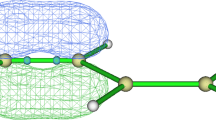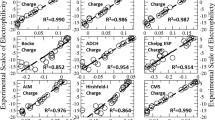Abstract
The present study applies all-electron relativistic DFT calculation with Douglas-Kroll-Hess (DKH) Hamiltonian to each ten sets of Ru and Os compounds. We perform the benchmark investigation of three density functionals (BP86, B3LYP and B2PLYP) using segmented all-electron relativistically contracted (SARC) basis set with the experimental Mössbauer isomer shifts for 99Ru and 189Os nuclides. Geometry optimizations at BP86 theory of level locate the structure in a local minimum. We calculate the contact density to the wavefunction obtained by a single point calculation. All functionals show the good linear correlation with experimental isomer shifts for both 99Ru and 189Os. Especially, B3LYP functional gives a stronger correlation compared to BP86 and B2PLYP functionals. The comparison of contact density between SARC and well-tempered basis set (WTBS) indicated that the numerical convergence of contact density cannot be obtained, but the reproducibility is less sensitive to the choice of basis set. We also estimate the values of ΔR/R, which is an important nuclear constant, for 99Ru and 189Os nuclides by using the benchmark results. The sign of the calculated ΔR/R values is consistent with the predicted data for 99Ru and 189Os. We obtain computationally the ΔR/R values of 99Ru and 189Os (36.2 keV) as 2.35×10−4 and −0.20×10−4, respectively, at B3LYP level for SARC basis set.
Similar content being viewed by others
References
Gütlich, P., Link, R., Trautwein, A.: Mössbauer Spectroscopy and Transition Metal Chemistry. Springer, Heidelberg (1978)
Neese, F., Petrenko, T.: Quantum chemistry and Mössbauer spectroscopy. In: Gütlich, P., Bill, E., Trautwein, A.X. (eds.) Mössbauer Spectroscopy and Transition Metal Chemistry –Fundamentals and Applications, pp 137–200. Springer, Heidelberg (2011)
Kaneko, M., Miyashita, S., Nakashima, S.: Benchmark study of Mössbauer isomer shifts of Eu and Np complexes by relativistic DFT calculations for understanding the bonding nature of f-Block compounds. Dalton Trans. 44, 8080–8088 (2015)
Kaneko, M., Miyashita, S., Nakashima, S.: Bonding study on the chemical separation of am(III) from eu(III) by S-, S-, and O-Donor ligands by means of all-electron ZORA-DFT calculation. Inorg. Chem. 54, 7103–7109 (2015)
Zhang, Y., Mao, J., Oldfield, E.: 57Fe Mössbauer isomer shifts of heme protein model systems: electronic structure calculations. J. Am. Chem. Soc. 124, 7829–7839 (2002)
Neese, F.: Prediction and interpretation of the 57Fe isomer shifts in Mössbauer spectra by density functional theory. Inorg. Chim. Acta. 337, 181–192 (2002)
Nemykin, V. N., Hadt, R. G.: Influence of hartree-fock exchange on the calculated Mössbauer isomer shifts and quadrupole splittings in ferrocene derivatives using density functional theory. Inorg. Chem. 45, 8297–8307 (2006)
Filatov, M.: First principles calculation of Mössbauer isomer shift. Coord. Chem. Rev. 253, 594–605 (2009)
Römelt, M., Ye, S., Neese, F.: Calibration of modern density functional theory methods for the prediction of 57Fe Mössbauer isomer shifts: meta-GGA and double-hybrid functionals. Inorg. Chem. 48, 784–785 (2009)
Neese, F.: The ORCA program system. WIREs Comput. Mol. Sci. 2, 73–78 (2012)
Nakajima, T., Hirao, K.: The Douglas-Kroll-Hess approach. Chem. Rev. 112, 385–402 (2012)
Visscher, L., Dyall, K. G.: Dirac-Fock Atomic electronic structure calculations using differenct nuclear charge distributions. Atom. Data Nucl. Data Tabl. 67, 207–224 (1997)
Filatov, M.: On the calculation of Mössbauer isomer shift. J. Chem. Phys. 127, 0841011–0841018 (2007)
Koch, K., Koepernik, K., Van Neck, D., Rosner, H., Cottenier, S.: Electron penetration into the nucleus and its effect on the quadrupole interaction. Phys. Rev. A 81, 0325071–03250716 (2010)
Pantazis, D. A., Chen, X., Landis, C. R., Neese, F.: All-Electron scalar relativistic basis sets for third-row transition metal atoms. J. Chem. Theory Comput. 4, 908–919 (2008)
Ahlrichs, R., May, K.: Contracted all-electron gaussian basis sets for atoms Rb to Xe. Phys. Chem. Chem. Phys. 2, 943–945 (2000)
Neese, F.: An improvement of the resolution of the identity approximation for the formation of the coulomb matrix. J. Comput. Chem. 35, 1740–1747 (2003)
Neese, F., Wennmohs, F., Hansen, A., Becker, U.: Efficient, approximate and parallel hartree-fock and hybrid DFT calculations. A ‘chain-of-spheres’ algorithm for the Hartree-Fock exchange. Chem. Phys. 356, 98–109 (2009)
Hardgrove, G. L., Templeton, D. H.: The crystal structure of ruthenocene. Acta Cryst. 12, 28–32 (1959)
Bobyens, J. C., Levendis, D. C., Bruce, A. I., Williams, M. L.: Crystal structure of Osmocene, Os(η-C5 H 5)2. J. Crystallogr. Spectrosc. Res. 16, 13244–13249 (1986)
Biner, B., Burgi, H. B., Ludi, A., Rohr, C.: Crystal and molecular structures of [Ru(byp)3](PF6)3 and [Ru(bpy)3](PF6)2 at 105 K. J. Am. Chem. Soc. 114, 5197–5203 (1992)
Constable, E. C., Raithby, P. R., Smit, D. N.: The x-ray crystal structure of tris(2,2’-bipyridine)osmium(II) Hexafluorophosphate. Polyhedron 8, 367–369 (1989)
Kaindl, G., Potzel, W., Wagner, F., Zahn, U., Mössbauer, R. L.: Isomer shifts of the 90 keV γ-rays of 99ru in ruthenium compounds. Z. Physik 226, 103–115 (1969)
Potzel, W., Wagner, F. E., Zahn, U., Mössbauer, R. L., Danon, J.: Isomer shifts and chemical bonding in ruthenium complexes. Z. Physik 240, 306–313 (1970)
Wagner, F. E., Kucheida, D., Zahn, U., Kaindl, G.: Mössbauer isomer shifts and quadrupole splittings in osmium compounds. Z. Physik 266, 223–232 (1974)
Huzinaga, S., Miguel, B.: A comparison of the geometrical sequence formula and the well-tempered formulas for generating GTO basis orbital exponents. Chem. Phys. Lett. 175, 289–291 (1990)
Huzinaga, S., Klobukowski, M.: Well-Tempered Gaussian basis sets for the calculation of matix Hartree-Fock wavefunctions. Chem. Phys. Lett. 212, 260–264 (1993)
Kurian, R., Filatov, M.: DFT approach to the calculation of Mössbauer isomer shifts. J. Chem. Theory Comput. 4, 278–285 (2008)
Author information
Authors and Affiliations
Corresponding author
Additional information
This article is part of the Topical Collection on Proceedings of the 15th Latin American Conference on the Applications of the Mössbauer Effect (LACAME 2016), 13–18 November 2016, Panama City, Panama
Edited by Juan A. Jaén
Rights and permissions
About this article
Cite this article
Kaneko, M., Yasuhara, H., Miyashita, S. et al. Estimation of ΔR/R values by benchmark study of the Mössbauer Isomer shifts for Ru, Os complexes using relativistic DFT calculations. Hyperfine Interact 238, 36 (2017). https://doi.org/10.1007/s10751-017-1413-y
Published:
DOI: https://doi.org/10.1007/s10751-017-1413-y




